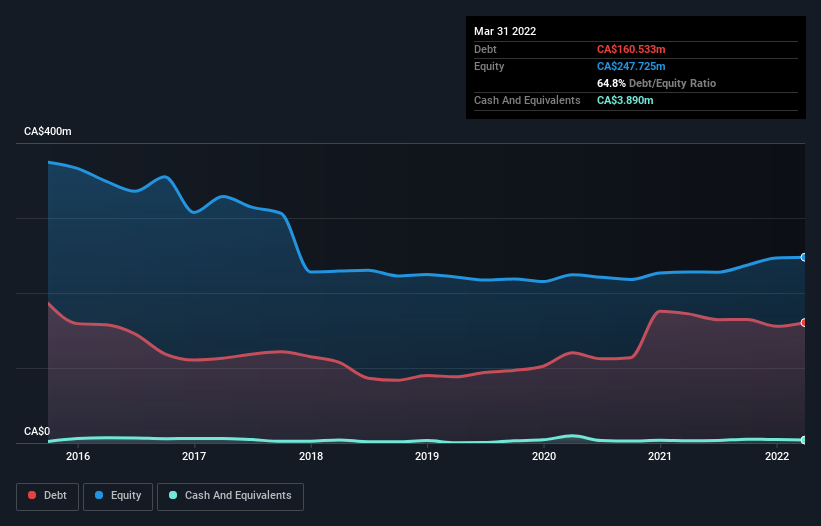
Howard Marks put it nicely when he said that, rather than worrying about share price volatility, 'The possibility of permanent loss is the risk I worry about... and every practical investor I know worries about.' When we think about how risky a company is, we always like to look at its use of debt, since debt overload can lead to ruin. As with many other companies Black Diamond Group Limited (TSE:BDI) makes use of debt. But the real question is whether this debt is making the company risky.
When Is Debt A Problem?
Debt assists a business until the business has trouble paying it off, either with new capital or with free cash flow. In the worst case scenario, a company can go bankrupt if it cannot pay its creditors. However, a more frequent (but still costly) occurrence is where a company must issue shares at bargain-basement prices, permanently diluting shareholders, just to shore up its balance sheet. Of course, plenty of companies use debt to fund growth, without any negative consequences. The first thing to do when considering how much debt a business uses is to look at its cash and debt together.
Check out our latest analysis for Black Diamond Group
How Much Debt Does Black Diamond Group Carry?
You can click the graphic below for the historical numbers, but it shows that Black Diamond Group had CA$160.5m of debt in March 2022, down from CA$172.2m, one year before. However, because it has a cash reserve of CA$3.89m, its net debt is less, at about CA$156.6m.

A Look At Black Diamond Group's Liabilities
The latest balance sheet data shows that Black Diamond Group had liabilities of CA$57.3m due within a year, and liabilities of CA$223.0m falling due after that. Offsetting this, it had CA$3.89m in cash and CA$60.8m in receivables that were due within 12 months. So its liabilities total CA$215.6m more than the combination of its cash and short-term receivables.
This deficit is considerable relative to its market capitalization of CA$226.0m, so it does suggest shareholders should keep an eye on Black Diamond Group's use of debt. Should its lenders demand that it shore up the balance sheet, shareholders would likely face severe dilution.
We use two main ratios to inform us about debt levels relative to earnings. The first is net debt divided by earnings before interest, tax, depreciation, and amortization (EBITDA), while the second is how many times its earnings before interest and tax (EBIT) covers its interest expense (or its interest cover, for short). This way, we consider both the absolute quantum of the debt, as well as the interest rates paid on it.
Black Diamond Group has a debt to EBITDA ratio of 2.7 and its EBIT covered its interest expense 5.4 times. This suggests that while the debt levels are significant, we'd stop short of calling them problematic. Notably, Black Diamond Group's EBIT launched higher than Elon Musk, gaining a whopping 521% on last year. There's no doubt that we learn most about debt from the balance sheet. But it is future earnings, more than anything, that will determine Black Diamond Group's ability to maintain a healthy balance sheet going forward. So if you're focused on the future you can check out this free report showing analyst profit forecasts.
Finally, a company can only pay off debt with cold hard cash, not accounting profits. So we always check how much of that EBIT is translated into free cash flow. Over the last three years, Black Diamond Group actually produced more free cash flow than EBIT. That sort of strong cash conversion gets us as excited as the crowd when the beat drops at a Daft Punk concert.
Our View
Both Black Diamond Group's ability to to convert EBIT to free cash flow and its EBIT growth rate gave us comfort that it can handle its debt. On the other hand, its level of total liabilities makes us a little less comfortable about its debt. When we consider all the elements mentioned above, it seems to us that Black Diamond Group is managing its debt quite well. Having said that, the load is sufficiently heavy that we would recommend any shareholders keep a close eye on it. The balance sheet is clearly the area to focus on when you are analysing debt. However, not all investment risk resides within the balance sheet - far from it. For instance, we've identified 2 warning signs for Black Diamond Group that you should be aware of.
When all is said and done, sometimes its easier to focus on companies that don't even need debt. Readers can access a list of growth stocks with zero net debt 100% free, right now.
Valuation is complex, but we're here to simplify it.
Discover if Black Diamond Group might be undervalued or overvalued with our detailed analysis, featuring fair value estimates, potential risks, dividends, insider trades, and its financial condition.
Access Free AnalysisHave feedback on this article? Concerned about the content? Get in touch with us directly. Alternatively, email editorial-team (at) simplywallst.com.
This article by Simply Wall St is general in nature. We provide commentary based on historical data and analyst forecasts only using an unbiased methodology and our articles are not intended to be financial advice. It does not constitute a recommendation to buy or sell any stock, and does not take account of your objectives, or your financial situation. We aim to bring you long-term focused analysis driven by fundamental data. Note that our analysis may not factor in the latest price-sensitive company announcements or qualitative material. Simply Wall St has no position in any stocks mentioned.
About TSX:BDI
Black Diamond Group
Black Diamond Group Limited rents and sells modular space and workforce accommodation solutions in Canada, the United States, and Australia.
Undervalued with mediocre balance sheet.
Similar Companies
Market Insights
Community Narratives



